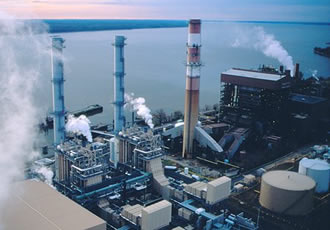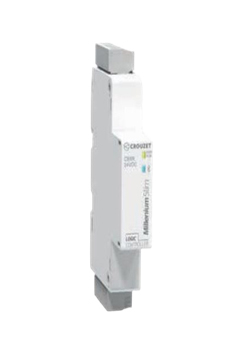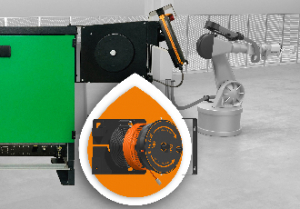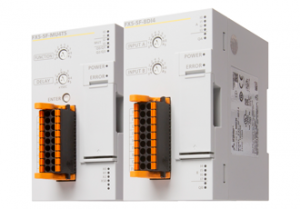Large power station maximises cooling tower performance

Controlling 22 cooling tower fans across two towers, the Possum Point Power Station is now using Control Techniques Unidrive M700 variable speed drives from Emerson. Replacing a system that was first installed in 1975, the advanced drive has brought many benefits.
It means now fan speeds can be varied to minimise power usage at low unit loads, eliminate windmilling due to a lack of a braking system, minimise freezing potential in winter, mitigate fan vibration without removing from service, and eliminate seasonal blade pitch adjustments required to prevent motor overloads in the winter and low air delivery in the summer.
Just the blade pitch adjustment itself resulted in a significant saving in man hours, which the power station estimates to be worth $38,000 per year.
The power station, located in the mid-Atlantic region of the USA, has multiple units firing gas and oil. The station was keen to implement an automated control system for its cooling fans, which were served by a system that was more than 40 years old. The retrofit addressed these issues directly:
Energy and cost reduction without impacting tower efficiency
To manage energy usage and cooling capacity meant turning the 200 HP fan starters on and off since they always ran full speed. The capability to vary fan speed and therefore cooling rate for different loads allows all fans to run (best tower efficiency) with much lower energy requirements. The system only moves as much air as is needed to extract heat and results in much less energy consumption.
To manage vibration on individual fans they had to be shutdown, even when load demand and therefore cooling demand were high. The capability to maintain all fans in operation, with some at reduced speed to manage vibration, provides optimum cooling when needed for unit generation.
Another issue was the need for manual seasonal fan blade pitch changes, due to differences in air density associated with summer and winter months. That alone demanded close to 480 man hours a year, a significant diversion of maintenance resources from more pressing needs around the plant plus crane rental and safety management required for blade pitch adjustments.
Asset management and protection
The fans have a 16ft long fibreglass/metal drive shaft connecting the fan gearbox and motor. With no braking system free wind milling of idle fans was a constant problem that sometimes resulted in bad starting scenarios that caused motor overloads, severe torsion forces on the drive shaft and sometimes gearbox problems. With the new system soft start and prestart braking are inherent in the M700 VSD capabilities. The addition of soft start and fan braking minimised torque peaks that the drive shaft experiences during fan starts and eliminated the wind milling concerns. The motors never see the high current applied by an across the line starter.
Freezing and thawing are a problem on cooling towers. The existing system required fans to be put in reverse if ice was forming on the sides of the towers in an attempt to thaw the heavy load on the tower intakes. These can have very damaging effects up to and including tower collapse. Properly managed air flow in cold weather using the variable speed capability can eliminate sub-cooling that, in turn, causes ice formation. This eliminates the need to reverse fans except in the most adverse weather conditions.
Mark Leigh, Technical Consultant for The Power Company said: “We decided to look at Variable Frequency Drive (VFD) solutions and three manufacturers were initially considered."
“However, Control Techniques [an Emerson company] was the only organisation that could meet the very short project delivery times we required. They were also very competent technically in terms of recommending an optimised solution.”
Leigh explained: “In a standard across-the-line starter fan motor, the variables are fan blade pitch and air density with a fixed maximum HP at a fixed speed, which was 1750rpm in this case.”
Control Techniques Unidrive M700 AC drives with real-time Ethernet capability were installed in a motor control room at the power station, where it is now used to control 22 cooling tower fans. Importantly for the station the Unidrive M700 has more control of the process.
“In contrast, the variables in a VFD-controlled fan motor are speed and air density with a fixed maximum HP at a fixed fan blade pitch. It therefore costs nothing in man hours to adjust the speed, as this is done automatically by the VFD based on a 200 HP limit, which is the maximum rating of the motor and starter. We estimate a saving of around four men for three weeks, or about 480 man hours, which equates to approximately $38,000 per annum.”
Similar articles
More from Emerson Industrial Automation, Control Techniques Ltd
- Completed acquisition of Intelligent Platforms business 18th December 2019
- SPS IPC Drives: improving plant reliability, safety and availability 29th October 2018
- Experts attend PPMA to improve food cutting processes 24th September 2018
- ASCO microfluidic valves can shorten product development cycles 9th May 2018












Write a comment
No comments